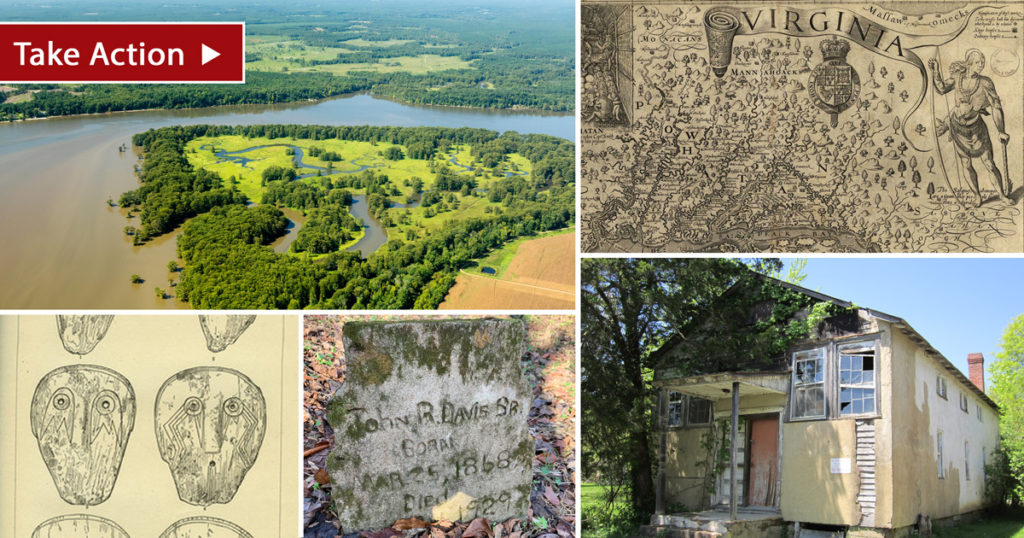
Support: 385 #5S – Historic Property Catalogue
Patron: Senator Jennifer McClellan
Preserving historic resources is crucial to understanding our nation’s history. However, historic resources related to African-American and indigenous communities are woefully underrepresented in Virginia’s state database. This has resulted in important resources being overlooked or worse yet, irretrievably lost, and has meant these communities are rarely included as part of larger historic district conversations.
Budget amendment 385 #5S (McClellan) provides $250,000 to the Department of Historic Resources (DHR) for the surveying of historic resources related to African American and Virginia Indian communities. If approved, it will support a staff position at DHR, a grant program to provide paid internships in partnership with Virginia’s Historically Black College Universities (HBCUs), and database enhancements for the Virginia Cultural Resources Information System (VCRIS).
The Piedmont Environmental Council is proud to have worked with Senator McClellan’s office on this amendment. Our look into previously listed National Register historic districts in our region made it clear to us that resources related to African American and Virginia Indian communities are sadly underrepresented in the state database. This amendment is critical to righting this lack of inclusion. In addition, including HBCUs in this effort increases diversity in the preservation field, raises awareness of the cultural importance of these institutions and recognizes the direct role they should play in uncovering these untold histories.
Send a Letter of Support to Your State Senator >>
Please lend your voice of support to this critical budget amendment by writing to your state senator.
If your senator is on Senate Finance and Appropriations…
If you recognize your delegate as serving on the Senate Finance and Appropriations committee, please consider making a direct phone call to their office in support of the budget amendment, as this committee will ultimately decide which amendments move forward.
Members of the committee:
| Last Name | First Name | District # | Capitol Phone | District Phone |
| Barker | George L. | 39 | 804-698-7539 | 703-303-1426 |
| Deeds | R. Creigh | 25 | 804-698-7525 | 434-296-5491 |
| Ebbin | Adam P. | 30 | 804-698-7530 | 571-384-8957 |
| Edwards | John S. | 21 | 804-698-7521 | 540-985-8690 |
| Hanger | Emmett W. | 24 | 804-698-7524 | 540-885-6898 |
| Howell (Chair) | Janet D. | 32 | 804-698-7532 | 703-709-8283 |
| Locke | Mamie E. | 2 | 804-698-7502 | 757-825-5880 |
| Lucas | L. Louise | 18 | 804-698-7518 | 757-397-8209 |
| Marsden | David W. | 37 | 804-698-7537 | 571-249-3037 |
| McClellan | Jennifer L. | 9 | 804-698-7509 | 804-698-7509 |
| Newman | Stephen D. | 23 | 804-698-7523 | 434-385-1065 |
| Norment | Thomas K. | 3 | 804-698-7503 | 757-259-7810 |
| Petersen | J. Chapman | 34 | 804-698-7534 | 703-3493361 |
| Ruff | Frank M. | 15 | 804-698-7515 | 434-955-2224 |
| Saslaw | Richard L. | 35 | 804-698-7535 | 703-978-0200 |
| Vogel | Jill Holtzman | 27 | 804-698-7527 | 540-662-4551 |
Additional talking points
- Several decades ago, the Virginia Department of Historic Resources (DHR) had staff dedicated to documenting and recording historic resources as an important process of gathering and understanding the historic fabric of communities across the commonwealth. Survey work is an absolutely necessary component of any historic preservation program, as it lays the groundwork for the identification, evaluation, and registration of properties. But if you don’t know where resources exist, you cannot actively plan for their protection.
Questions? Contact PEC’s director of state policy, Dan Holmes, at dholmes@pecva.org.
Detailed photo descriptions
Aerial – An aerial view of Weyanoke, located on the James River in Charles City County, VA. The area is named for the Weyanoke (also spelled Weanoc), a tribe of the Powhatan Confederacy, which historically inhabited the area. Weyanoke was also the first African community in North America. Photo by Will Parson, Chesapeake Bay Program. (source)
Drawing – “The Human Face” illustration depicts shell gorgets, carved decorative shells worn around the neck, an art form excavated at Virginia Indian sites like Ely Mound in Lee County. Original Author: William Henry Holmes, courtesy of the University of Virginia. (source)
Map – John Smith’s map, first published in England in 1612, was the primary map of the Chesapeake region for decades. Included are not only the geographic features of the Chesapeake, but also its cultural aspects, including more than 200 Indian towns. Courtesy the Library of Congress. (source)
Headstone -The headstone marks the burial location of John R. Davis, and is one of a number of cast, inscribed headstones at the Fishermen’s Lodge cemetery in Little Petersburg, an African-American community in Orange County established after emancipation. Davis was one of the early landowners in Little Petersburg. Photo by Kristie Kendall.
Building – The Remington No. 15 School, also known as “Piney Ridge” was one of eight Rosenwald Schools constructed in Fauquier County for African-American students through the partnership between Julius S. Rosenwald and Booker T. Washington. The pair joined forces with African-American communities throughout the South and built more than 5,300 schools during the early 20th century. Photo by Kristie Kendall.

